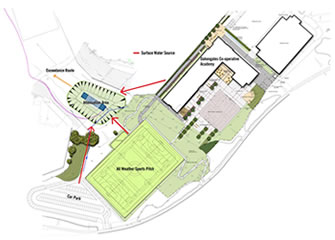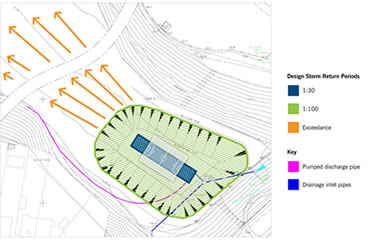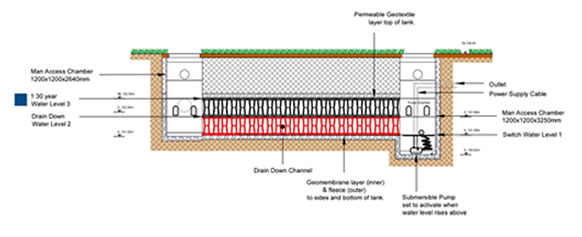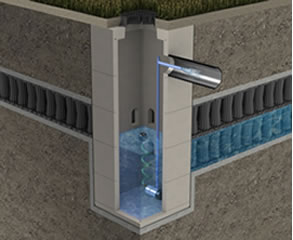Where
Location: New Road, Wrockwardine Wood, Telford, TF2 7AB
Description
Telford & Wrekin Council proposed a brand new school as part of the Building Schools for the Future Programme: the Oakengates Co-operative Academy formed from Sutherland Business and Enterprise College and Wrockwardine Wood Performing Arts College. The project encompassed substantial refurbishment to the existing leisure centre, a new school which together with a new all-weather sports field and car park formed three substantial drainage elements indicated in Figure 1.
Figure 1. Major drainage elements
Managing rate and volume of runoff was a key focus as Infiltration had to be ruled out for the site as a whole as it sits on clay with a little over 100mm of top soil that becomes quickly saturated. In particular, the scheme required careful consideration of exceedance management. The original plan was for drainage connection to a culverted water course and a drainage system with the necessary attenuation to discharge in the order of 24 l/s.
Further inspections revealed the culvert contained residual mining water, referred to as ‘ochre water’ due to its colour, and importantly indicated the extent of the pipework that would fall under riparian ownership of the numerous residential properties. As Telford & Wrekin had committed to facilitating discharge across the whole build, a rapid solution was required in order to avoid contractual penalties that would amount to £20k per week. A nearby highway surface water sewer provided a potential solution.
Main SuDS used
This fundamental change in surface water destination required further significant attenuation to 5 l/s. Furthermore, consideration of distance to outlet became important especially as contaminated ground featured along the proposed route. A combination of a surface detention formed by a topographic depression, indicated in figure 2, together with underground storage and a pumped discharge, required shallow excavation and facilitated re-use of site spoil that would have necessitated off-site disposal. This design then communicates to a much larger surface area enabling the management of drainage exceedance caused by rare events.

Figure 2. Looking out toward the proposed attenuation area
How it works
An assessment was made for connection to a highway surface water sewer 400m from site boundary with a discharge limit imposed by the sewerage undertaker of 5l/s. In addition, Telford & Wrekin Engineers had to accommodate a third, as yet, un-attenuated drainage element for the car park. With the clear priority focussed on surface water quantity, managing water on or near the surface became a design goal not only to reduce costs but also to facilitate easy maintenance.
As the runoff exceeded discharge limits imposed by Telford and Wrekin’s Highway Drainage section, further attenuation was necessary. Initial designs considered 1000m3 of underground attenuation with gravity feed to sewer at an estimated cost of £0.5m. This was likely to be exacerbated by the potential for managing the risk of excavations in adjacent contaminated land. A further driver of the eventual design was the potential to incorporate multi-functional elements in to the scheme as illustrated in figure 3. An improvement in amenity was proposal for a ‘five-a-side’ sports pitch which was welcomed by stakeholders.
Figure 3. Runoff management integrating sub-surface attenuation and multi-functional elements such as the five-a- side sports pitch
Specific details
To ensure the scheme remained financially viable, the use of pumps and a rising main system was used to minimise excavation. Directional drilling at depths of 1-1.2m appeared feasible, avoiding disturbance of contaminated ground. Test inspection confirmed capacity to design for the depths indicated, and subsequently an 90mm pipe was installed over a distance in excess of 400m over 3 days and saving an estimated £120k when compared to a gravity outfall that would require contaminated ground mitigation. Two pumps are provided for failsafe operation which are are located at the low point of the underground attenuation system in a submerged sump allowing useful pump temperature moderation. Activation is by pressure as opposed to conventional float switches in order to minimise likelihood of failure. As the drainage is to be maintained by the client, a 10 year maintenance package for the pumps was negotiated. The use of the regulated flow from the pump provided cost reductions as the car park drainage could be installed without attenuation.
With all three run off elements now convening at one location, consideration was given to the final aspects of the attenuation system with design goals of cost reduction.
Around 1000m3 of surface water had to be managed. This derived for the critical volume of the 1:100 year event with an uplift of 30% for climate change. Originally this was intended to be attenuated underground in proprietary storage tanks but with limited accessibility to site this solution was not ideal. The design specification was changed to another proprietary geocellular drainage system where components could be packaged and transported efficiently – enabling a 5:1 reduction in transport. The sub surface system design is illustrated in Figure 4 indicating the second lower level drain down channel and interconnected access chambers.

Figure 4. Subsurface attenuation system, man access units, drain down channel and submersible pump
Temporary ponding and storage was provided by creating a shallow depression utilising spoil from the main contract. A topographic depression was created with a 1:15 gradient (<7%). This reduced the underground storage to just 175m3, with 800m3 on the surface, with freeboard, depth is just 0.75m at the lowest point should such an event occur. Drainage of the permeable area itself had to be accommodated as the clay substrate prevents infiltration. To achieve this a shallow land drain feeds into the attenuation system. To facilitate inspection and maintenance provision was made for man access chambers illustrated in Figure 5.

Figure 5. Subsurface attenuation installation and access chambers
The ‘offline’ design approach confines the majority of flows to the drain down channel (figure 3). Higher volume events only progressively encroach on the sub surface system as it is laid on a gradient to help minimise sedimentation. Key design features include:
- Pump in sump at lowest level – submerged
- The proprietary attenuation system is itself laid to a gradient of 0.7% over a 30m length illustrated in Figure 6
- A lower level drain down channel is installed at low point of the main attenuation system
- Surface inlets / outlets are incorporated at 4 corners.

Figure 6. Gradient on subsurface attenuation – minimising sedimentation
Sediment control is a vital consideration with such designs and this is achieved by design and product selection:
- Influent sediment from the three contributing areas is concentrated in sump. The gradient on the attenuation system should minimise sediment build up when and if capacity is utilised
- Man-access units are installed at each lower corner. Inspection chambers at the upper corners also provide venting.
- The underground storage product design enabled though system inspection via use of mobile CCTV and use of remote jetting.
The redesigned underground system, though massively reduced from its original design volume, will still accommodate 1:30 year (33% probability) events – the point at which surface ponding is likely. Conveyance to the surface is achieved via the four corner inspection / man access units which will be fitted with open gully gratings enabling two-way flow. Multi-functionality was achieved by a layout that enabled the installation of a five-a-side pitch within the confines of the four inlet / outlet points.
Exceedance management beyond the hydraulic capacity of the surface and sub-surface structures is facilitated by use of public open space land under Local Authority control that required only a relatively minor adjustment to a bund height near a residential property around 700m away to effect a further 2000m3 capacity. Figure 7 illustrates the extent of area.

Figure 7. Greater than 1:100 plus climate change exceedance route and storage
Benefits and achievements
- The overall design achieved a total saving in the order of £250k over what was originally proposed.
- The outcome manages water on the surface, and in combination with proprietary systems, has enabled a versatile multifunctional area whilst providing exceedance management at little extra cost.
- Disruption to the community was minimal and positive feedback is being received.
Challenges and lessons learnt
- Multi-functionality has delivered a more cost effective and beneficial approach to managing surface water runoff
- Faced with potentially significant contractual penalties Telford and Wrekin Council engineers managed water on the surface to achieve a valuable amenity benefit that the community welcomed – a new sports pitch that also provides cost effective exceedance management.
Team
Designed and Constructed by Telford and Wrekin council. Contact: Gerrol Jalving: Gerrol.Jalving@telford.gov.uk
Client. Oakengates Co-operative Academy
Status. Completed August 2014



